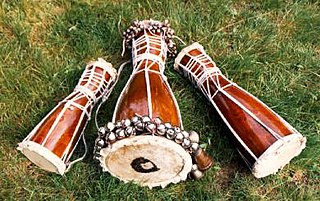
A percussion instrument is a musical instrument that is sounded by being struck or scraped by a beater including attached or enclosed beaters or rattles struck, scraped or rubbed by hand or struck against another similar instrument. Excluding zoomusicological instruments and the human voice, the percussion family is believed to include the oldest musical instruments. In spite of being a very common term to designate instruments, and to relate them to their players, the percussionists, percussion is not a systematic classificatory category of instruments, as described by the scientific field of organology. It is shown below that percussion instruments may belong to the organological classes of idiophone, membranophone, aerophone and chordophone.
Highlife is a Ghanaian music genre that originated along the coastal cities of present-day Ghana in the 19th century, during its history as a colony of the British and through its trade routes in coastal areas. It describes multiple local fusions of African metre and western jazz melodies. It uses the melodic and main rhythmic structures of traditional African music, but is typically played with Western instruments. Highlife is characterized by jazzy horns and guitars which lead the band and its use of the two-finger plucking guitar style that is typical of African music. Recently it has acquired an uptempo, synth-driven sound.

The balafon is a gourd-resonated xylophone, a type of struck idiophone. It is closely associated with the neighbouring Mandé, Bwaba Bobo, Senoufo and Gur peoples of West Africa, particularly the Guinean branch of the Mandinka ethnic group, but is now found across West Africa from Guinea, Burkina Faso, Mali. Its common name, balafon, is likely a European coinage combining its Mandinka name ߓߟߊ bala with the word ߝߐ߲ fôn 'to speak' or the Greek root phono.
There are many styles of traditional and modern music of Ghana, due to Ghana's worldwide geographic position on the African continent.

The clave is a rhythmic pattern used as a tool for temporal organization in Brazilian and Cuban music. In Spanish, clave literally means key, clef, code, or keystone. It is present in a variety of genres such as Abakuá music, rumba, conga, son, mambo, salsa, songo, timba and Afro-Cuban jazz. The five-stroke clave pattern represents the structural core of many Cuban rhythms. The study of rhythmic methodology, especially in the context of Afro-Cuban music, and how it influences the mood of a piece is known as clave theory.

The music of Togo has produced a number of internationally known popular entertainers including Bella Bellow, Akofah Akussah, Afia Mala, Itadi Bonney, Wellborn, King Mensah and Jimi Hope.

Developed and used by cultures living in forested areas, drums served as an early form of long-distance communication, and were used during ceremonial and religious functions.
Hiplife is a Ghanaian musical style that fuses Ghanaian culture and hip hop. Recorded predominantly in the Ghanaian Akan language, hiplife is rapidly gaining popularity in the 2010s throughout West Africa and abroad, especially in the United Kingdom, United States, Canada and Germany.

The Ewe people are a Gbe-speaking ethnic group. The largest population of Ewe people is in Ghana, and the second largest population is in Togo. They speak the Ewe language which belongs to the Gbe family of languages. They are related to other speakers of Gbe languages such as the Fon, Gen, Phla /Phera, Ogun/Gun, Maxi, and the Aja people of Togo and Benin.

The music of West Africa has a significant history, and its varied sounds reflect the wide range of influences from the area's regions and historical periods.

African dance refers to the various dance styles of sub-Saharan Africa. These dances are closely connected with the traditional rhythms and music traditions of the region. Music and dancing is an integral part of many traditional African societies. Songs and dances facilitate teaching and promoting social values, celebrating special events and major life milestones, performing oral history and other recitations, and spiritual experiences. African dance uses the concepts of polyrhythm and total body articulation. African dances are a collective activity performed in large groups, with significant interaction between dancers and onlookers in the majority of styles.

The Batá drum is a double-headed hourglass drum with one end larger than the other. The percussion instrument is still used for its original purpose as it is one of the most important drums in the Yoruba land and used for traditional and religious activities among the Yoruba. Batá drums have been used in the religion known as Santería in Cuba since the 1800s, and in Puerto Rico and the United States since the 1950s. Today, they are also used for semi-religious musical entertainment in Nigeria and in secular, popular music. The early function of the batá was as a drum of different gods, of royalty, of ancestors and a drum of politicians, impacting all spheres of life in Yoruba land.
Kpanlogo is a recreational dance and music form originating from the 1960s among urban youth in Accra, Ghana.
Ewe drumming refers to the drumming ensembles of the Ewe people of Ghana, Togo, and Benin. The Ewe are known for their experience in drumming throughout West Africa. The sophisticated cross rhythms and polyrhythms in Ewe drumming are similar to those in Afro-Caribbean music and late jazz. The original purpose of Ewe drumming were sung or performed by warriors. Now the songs and performed to celebrate or for recreational use. For example, Agbadza was originally used as a warrior dance but is now used to celebrate events.

In many parts of sub-Saharan Africa, the use of music is not limited to entertainment: it serves a purpose to the local community and helps in the conduct of daily routines. Traditional African music supplies appropriate music and dance for work and for religious ceremonies of birth, naming, rites of passage, marriage and funerals. The beats and sounds of the drum are used in communication as well as in cultural expression.
Yacub Addy was a Ghanaian traditional drummer, composer, choreographer and educator who collaborated with many musicians in various genres, including Wynton Marsalis. He has been referred to as "the leading ambassador of Ghanaian music and culture".
Nyabinghi, also Nyahbinghi, Niyabinghi, Niyahbinghi, is the gathering of Rastafari people to celebrate and commemorate key dates significant to Rastafari throughout the year. It is essentially an opportunity for the Rastafari to congregate and engage in praise and worship. For example, on July 23 of each year, a Nyabinghi is held to celebrate the birth of Emperor Haille Selassie I. During a Nyabinghi celebration men and women have different roles and expectations. Men are expected to remove any hair coverings, whilst women must keep their hair covered. A group of men typically organise themselves in a line or semi-circle and are assigned to beat the drums throughout. The remaining congregation continue to sing well known songs or 'chants', some of which are Hebraic scriptural verses that evidence the divinity of Haile Sellassie. For example, 'I have a little light in I and I'm going to make it shine, Rastafariiii, shine' and 'Holy Mount Zion is a holy place and no sinners can enter there, so let the words of my mouth and the mediation of my heart, be acceptable in thy sight, of Rastafari'. Nyabinghi is a Rastafari tradition that promotes Rastafari unity, strengthens the Rastafari spirit with fellowship and raises the consciousness and presence of Rastafafari in the heart of those in attendance. At some points passages of the bible are read. Rastafari recognise the significance of Jesus Christ, due to Haile Sellassie I fulfilling the teachings and prophecy of scripture. Nyah Bingi came before Rastafari Nyah is the Highest

Agbadza is an Ewe music and dance that evolved from the times of war into a very popular recreational dance. It came from a very old war dance called Atrikpui and usually performed by the Ewe people of the Volta Region of Ghana, particularly during the Hogbetsotso Festival, a celebration by the Anlo Ewe people. In addition, it is also performed by Togolese and Beninese of Ewe descent. The dance has five movements in performing it, 1. Banyinyi which is a short introductory in prayer to the gods and ancestors, 2. Vutsortsor which is the main dance, 3. Adzo- which is less energetic and only the master is made to drum along with Gankogui and Axatse, 4. Hatsatsa- historical songs are performed along with Gankogui and Atoke, 5. Vutsortsor- finally, another round of the main dance which usually last for a number of hours. Gankogui is an instrument in a form of a bell where a stick is used to play. Atoke is also an iron banana shaped bell and played with a small forged iron rod. The Atoke can be used in place of the Gankogui they are both used for the same purpose.
Nakorex were a Ghanaian Highlife supergroup active in the 1990s. The band was formed in 1992 by the musicians Nat Brew, Rex Omar, and Akosua Agyapong, and took its name from the first few letters of each member's name. Brew and Agyapong were later married. Their musical style combined high-tech and standard instruments, with an emphasis on live performances. The biggest song of the collective was Kpanlogo Yede, which is regarded as a classic Ghanaian song utilizing the kpanlogo drums and rhythms popular in Kpanlogo.











